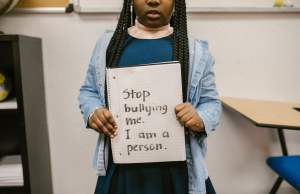From elementary school through high school, many children experience bullying from their classmates every year. Bullying is harmful to all parties and can cause lingering emotional trauma that affects children well into adulthood.
In an effort to protect kids and limit bullying’s damaging effects, October has been recognized as National Bullying Prevention Month. This national event is meant to inspire more people to get involved in spreading awareness about bullying and educating others on what their role could be in preventing it.
Whether you learn how to spot the signs of bullying in your child or simply wear orange on Unity Day, taking action during National Bullying Prevention Month will move us one step closer to putting a stop to bullying.

Types of Bullying
There are three main types of bullying: Verbal, physical, and social:
- Verbal bullying is the act of expressing mean or rude things through spoken or written words. This can look like teasing, name-calling, using racial slurs, or threatening someone.
- Physical bullying can come in the form of hitting or punching, tripping, pushing, and stealing and breaking belongings.
- Finally, there’s social bullying. Often, this looks like excluding, spreading rumors about one or more individuals, intentionally embarrassing someone, or telling others not to be friends with a particular person.
Since bullying is largely a problem in schools, in the past students could sometimes find an escape from bullying at home. However, the advent of technology, cyberbullying—or bullying using the internet and social media—has worsened the issue.
Now, bullied kids can’t always get away from their tormentors, since they can reach them from just about anywhere. Even so, there’s always action that can be taken to prevent bullying from happening, which is where National Bullying Prevention Month comes in.
What Is Bullying Prevention Month?
National Bullying Prevention Month is observed all across the United States during the month of October. Started in 2006 by PACER’s National Bullying Prevention Center, this event helps draw attention to the harm bullying causes to youth in the U.S. and around the world.
Supporting Bullying Prevention Month, there’s also Unity Day, celebrated this year on October 19th. There’s also World Day of Bullying Prevention, held on the first Monday of October.
Hello, we're here to help you
We provide award-winning mental health services nationwide, with flexible scheduling & insurance coverage. Start your journey this week.
Goals and Objectives of Bullying Prevention Month
The following goals and objective of Bullying Prevention Month guide nationwide efforts to combat bullying effectively, encouraging us to start by:
- Elevating awareness: The foremost aim is to enhance awareness, shedding light on the pervasive issue of bullying, its prevalence, and the detrimental consequences it inflicts upon our schools, workplaces, and communities.
- Knowledge dissemination: Bullying Prevention Month strives to equip individuals with educational resources and insights, enabling them to discern the multifaceted nature of bullying, encompassing cyberbullying, verbal harassment, and the profound impact it exacts upon its victims.
- Empowerment: Bullying Prevention Month also strives to empower individuals, with a special focus on students, emboldening them to raise their voices and report incidents of bullying. We encourage them to be proactive allies, fostering a supportive environment that thwarts bullying.
- Fostering kindness and respect: This observance inspires all to cultivate a culture anchored in kindness, empathy, and respect within our educational institutions and workplaces, serving as a robust preventive barrier against bullying.
- Advocate for policy reform: During October, you can passionately advocate for the formulation and enforcement of anti-bullying policies and legislation, fostering a safer, more accountable society at local, state, and national levels.
- Support networks for victims: Recognizing the struggles of bullying victims, we are encouraged to stay committed to offering robust support systems and resources, facilitating their resilience, recovery, and emotional well-being.
- Enrich training and education: We champion comprehensive training and educational programs tailored for educators, parents, and community members, empowering them to detect and address bullying with efficacy.
- Community involvement: By fostering community engagement through thought-provoking events, workshops, and discussions, we endeavor to cultivate a united front against bullying.
- Digital safety advocacy: In recognition of the escalating frequency of cyberbullying, you can impart vital knowledge on digital safety and responsible online conduct, empowering individuals to navigate the digital landscape securely.
In pursuit of these unique objectives, Bullying Prevention Month aspires to carve a path toward safer, more compassionate, and inclusive settings where children and adults alike are fortified to both prevent and address bullying incidents more efficiently.
The Significance and Origin of the Campaign
Bullying Prevention Month was founded at The PACER Center, which works on behalf of children, youth, and young adults with disabilities.
What Color Represents National Bullying Prevention Month?
Orange represents National Bullying Prevention Month.
Getting Involved in Bullying Prevention Month
One can get involved with Bullying Prevention Month by:
- Taking a pledge to help prevent bullying
- Educating children and their parents about bullying and what to do if they are bullied
- Wearing orange during the month of October to spread awareness
- Use the hashtags #BlueUp or just #bullyingpreventionmonth to help get the word out and remind people that October is Bullying Prevention Month.
And if you’d like to get involved in something more action-based, there are a variety of activities and fundraisers on the national and local levels that you can take part in, such as the Run, Walk, Roll Against Bullying, a virtual event led by PACER.
But perhaps more importantly, spotting the signs of bullying is often a frontline defense in the fight against bullying. Many children might not feel comfortable broaching the subject themselves with parents or teachers.
If you notice indicators that your child or a child you know may be a victim of bullying or could be bullying others, it’s important to have thoughtful conversations with them about it as appropriate (or alert their teacher, parent, or legal guardian) as they will either need a safe space to air out their troubles, or these signs could be pointing to other issues like depression.
According to Stopbullying.gov, these are some common warning signs that your child could be being bullied:
- Strange injuries
- Clothing, books, electronics, or other belongings being lost or destroyed
- Feeling sick, frequent headaches or stomach aches, or faking illness
- Unusual eating habits, like skipping meals, frequent binge eating, or coming home hungry
- Worsening grades, loss of motivation, not wanting to go to school
- Sudden loss of friends or avoidance of social situations
- Decreased self-esteem or feelings of helplessness
- Self-destructive habits like running away from home, talking about suicide, or harming themselves
Next, here are signs that your child might be bullying others:
- Increase in physical or verbal fights
- They’re friends with kids who bully others
- Increased aggression
- Frequent visits to detention or the principal’s office
- You’re finding unexplained extra money or new belongings on them
- Deflecting by blaming other people or circumstances for their problems
- Refusal to accept responsibility for their actions
Participating in Community Events and Workshops
Organizations and stakeholders to work with during National Bullying Prevention Month include:
- Police officers
- Educators
- Local elected officials
- Mental health professionals
- Parents
Facilitating conversations around bullying with community members and creating a safe space for your child to speak about their problems is a vital part of giving kids hope in these dreadful situations. By making them feel heard, it can help both a bullied child and a bully admit what’s really happening and stop the bullying from continuing.
Advocating for Bullying Prevention in Schools and Organizations
One may advocate for bullying prevention month in the schools by reaching out to school officials to develop a school wide anti-bullying policy to promote an environment that is conducive for growth and learning.
Strategies to Combat Bullying
Some of the best strategies to combat bullying include:
- Talking with kids about how their behavior impacts others
- Encouraging kindness
- Explaining how children of different backgrounds and abilities can experience unfair treatment based on how they look
- Having conversations about feelings
- Teaching children self-control to decrease impulsive behaviors
- Teaching children how to be assertive and how to set boundaries
- Encourage your child to keep a peer around them to stop bullying attempts
- Contact the school staff to come up with a plan together
Lastly, attempt to discourage bullying by teaching children to first try simply ignoring the behavior. Ignoring the bully will be less rewarding for the bully, who will be less likely to continue the behavior with someone who ignores them.
Fostering Empathy and Respect in Communities
Spend time with those you know less well and ask them about themselves, what their childhood was like growing up, and what their day to day looks like. Be present and attentive when talking to those within your community, school, work place, or social circle.
Building Strong Support Systems for Targets of Bullying
Here are steps to create robust support networks for bullying victims:
- Provide emotional support: Extend a comforting presence, offering empathy to assure them that their emotions are valid, and they are not alone in their challenges. Sometimes, a sympathetic ear can make a profound difference.
- Foster open communication: Cultivate a secure and open environment where individuals targeted by bullying feel safe discussing their experiences. Assure them that your door is always open for conversations.
- Respect their choices: Acknowledge that those experiencing bullying may have their reasons for handling the situation in a specific way. Respect their decisions, even if they differ from your suggestions.
- Introduce new resources for coping with bullying: Assist in locating pertinent resources such as support groups, counseling services, or specialized mental health professionals well-versed in addressing the impact of bullying.
- Aid in reporting and documentation: If appropriate, provide support in reporting bullying incidents to relevant authorities such as school administrators, HR departments, or law enforcement. Help them document incidents, including details like dates, times, and descriptions.
- Raise awareness together: Collaborate with those affected by bullying to raise awareness within their community or organization, potentially preventing future incidents and instilling a sense of empowerment.
- Monitor emotional well-being: Keep a watchful eye on their emotional state, regularly checking in with them to convey your ongoing availability for support.
- Encourage professional help when necessary: If someone targeted by bullying experiences severe emotional distress or mental health challenges, motivate them to seek professional assistance from therapists or counselors.
- Recognize your limits: While providing support, acknowledge your own boundaries and limitations. If the situation demands specialized expertise, consider involving professionals trained to handle such cases.
Building a robust support system demands patience, empathy, and consistent effort. By extending understanding, access to resources, and a helping hand, you can guide those affected by bullying toward reclaiming their sense of safety and well-being.
Helplines and Support Organizations to Contact
Below is a list of organizations to contact for resources and information regarding bullying and bullying prevention:
In conclusion, National Bullying Prevention Month in October serves as a crucial reminder of our collective responsibility to protect children from the long-lasting effects of bullying. By fostering awareness, support, and empathy within our communities, we can work together to create a safer and more inclusive environment for all, ultimately putting an end to bullying’s harmful impact.













